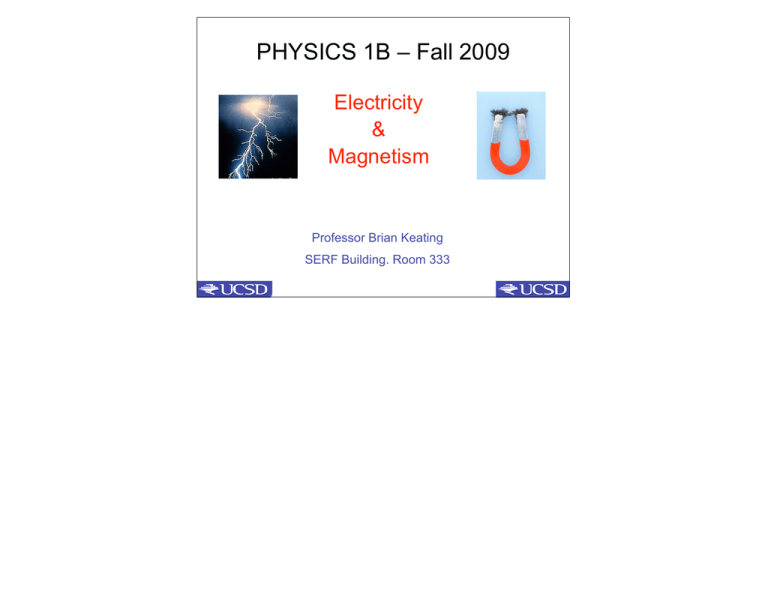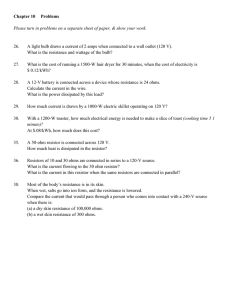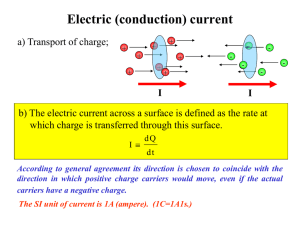PHYSICS 1B – Fall 2009 Electricity & Magnetism
advertisement

PHYSICS 1B – Fall 2009 Electricity & Magnetism Professor Brian Keating SERF Building. Room 333 Two Week Schedule • Today: Current, resistance • Circuits: Ch 18 • Friday 11/6: QUIZ 3 (Ch 17 and 18) • Quiz results – posted soon 17.1 Electric Current Electric current Drift speed Current sources: Batteries Charge flow slowly in a wire Carry kinetic energy like water in a pipe The energy can be released eg. Lightbulb q I q There is an electric field in the conductor. Non-Equilibrium System. – Charges move Electric Current, I rate of +charge flow through a surface +q I Units Coulombs/sec – Ampere (A) A flashlight bulb carries a current of 0.1 A. (a) Find the charge passed in 10 s. (b) How many electrons does this correspond to? (a) (b) Drift Velocity E e- Collisions of electron with the lattice (a.k.a resistance) slows down the velocity. Drift velocity- Average velocity in the direction of the flow. A Current – like a fluid through a pipe. Rate of flow is Vd –Drift velocity n – no. of charge carriers/volume q- charge per charge carrier 17.2 Find the drift velocity of electrons in Cu. For I=10 A, A=3x10-6 m2. Use density of Cu, ρ=8.95 g/cm3(each atom of Cu contributes 1 carrier electron) MA=63.5g/mole I vd The drift velocity is very low. The current is large because of the large number of charge carriers. The electrical signal travels fast, because electrons interact and “push” other electrons in the conductor PHYSICS 1B – Fall 2007 Electricity & Magnetism Professor Brian Keating SERF Building. Room 333 Amp hour ( unit of charge) How much charge is equal to 2100 mAh (milliamp hours) charge=(current)(time) Ni-MH Nickel metal hydride battery A battery with a 2 amp hr rating is used to power a flashlight that draws 5 A of current. How long will the battery last Resistance Chapter 17.4 Resistance R units Volts/Ampere , Ohms (Ω) I R ΔV Resistance I V1 ΔV V2 Resistance, units Volts/Ampere = Ohm (Ω) Resistance causes conversion of potential energy to heat. Resistors carbon resistors wire wound resistors thin metal film resistors Ohm’s Law For many conductors I is linear with ΔV, I Slope=1/R ΔV R is a constant Gravitational analogy to ΔV=IR Water flow in a river Water flow is fast where the slope is steep (large potential drop). H2O resistor E&M & H2O E&M & H2O Inductor Inductor Inductor Inductor Some materials show non-ohmic resistance Semiconductor diode I I ΔV Does the resistance of the diode increase or decrease as ΔV increases? Resistors carbon resistors wire wound resistors thin metal film resistors Resistance of a resistor is determined by the geometry of the resistor and the resistivity. Resistivity, ρ Property of conducting material L A Resistivity, ohms meter (Ω·m) Voltage – Pressure Analogy A light bulb connected to a 3.0 V battery draws a current of 0.2 A. Find the resistance of the light bulb. I ΔV R We assume that the resistance of the wires is negligible compared to the resistance of the light bulb. Voltages in Parallel Circuits with Resistors Resistance of a resistor is determined by the geometry of the resistor and the resistivity. Resistivity, ρ Property of conducting material L A Resistivity, ohms meter (Ω·m) Resistivities of different materials Material Resistivity,ρ (Ω·m) Copper 1.7x10-8 Iron 10x10-8 Carbon 4x10-5 Silicon Glass 6x102 1010-1014 NaCl solution(sat.) 4x10-2 Blood 1.5 A block of metal has a resistance R. If each of the dimensions of the block are doubled, what will the resistance be? L h w L= 2Lo w= 2wo h= 2ho Electrons in a Resistor F= ma = qE Lines of Electric Force (-Electric Field) Atoms of Resistor Material (e.g. Carbon) Resistor Fabrication A power cable made out of copper has a length of 10m has an diameter of 2 mm. Find the resistance of the wire. ρCu =1.7x10-8Ω·m. A L Resistance of a light bulb filament. Thin tungsten coil. R=150 Ω ρ =73 x10-8 Ω−m (at 2000 C) L=0.5 m Find the diameter of the wire. 55 µm Temperature dependence of resistance metal conductors At higher T the collisions with the lattice are more frequent. vD becomes lower R becomes larger Temperature coefficient of resistivity For small changes in T ρ slope =α T Material α (Co)-1 near 20o C Copper 3.9x10-3 Tungsten 4.5x10-3 Silicon -7.5x10-3 Thermometry A platinum resistance thermometer uses the change in resistance to measure temperature. If a student with the flu has a temperature rise of 4.5o C measured with a platinum resistance thermometer and the initial R= 50.00 ohms. What is the final resistance? α=3.92x10-3 oC-1 Electrical energy, power The power dissipated in a resistor is due to collisions of charge carriers with the lattice. Electrical potential energy is converted to Kinetic energy is converted into heat. ΔV Energy dissipated in a resistor I ΔV R ΔV Voltage drop Change in PE =qΔV Dissipated as heat Power dissipated in a resistor Three equivalent relations for the power A lightbulb has an output of 100 W when connected to a 120V household outlet. What is the resistance of the filament? ΔV A heating element in an electric range is rated at 2000 W. Find the current required if the voltage is 240 V. Find the resistance of the heating element. Cost of electrical power Kilowatt hour = 1kW x1hr=1000J/s(3600s)=3.6x106J 1kW hr costs ~ $0.15 How much does it cost to keep a 100W light on for 24 hrs? A 10 km copper power cable with a resistance of 0.24 Ω leads from a power plant to a factory. If the factory uses 100 kW of power at a voltage of 120 V how much power would be dissipated in the cable. R=0.24Ω Pf=105 W 120 V A large current is required to provide this power at low voltage Very lossy cable Power Transmission High voltage ΔVtrans=105V Power loss=I2Rwire Power transferred=ΔVtrans I transformer ΔV=120 V Low voltage High voltage transmission- power transmitted with lower current. Therefore lower I2R loss in the line.






